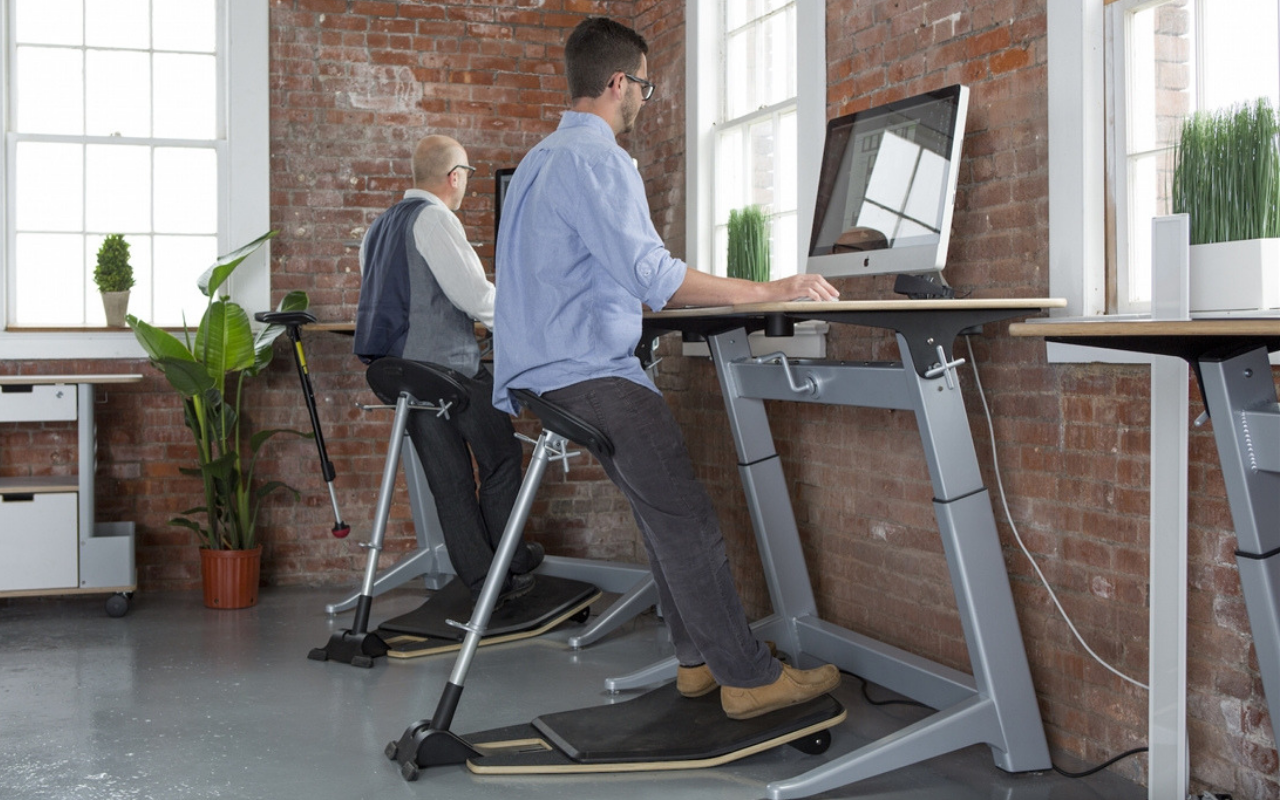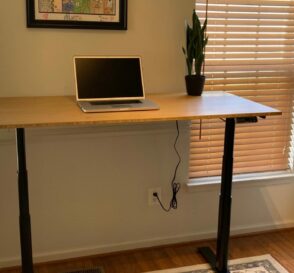Standing desks have grown to become popular items among employees working the daily grind in office environments. It’s not because hipsters or health nuts alone are attracted to these types of items. People all over the world want in because it is the polar opposite of sitting all day. But…is standing the polar opposite when it comes to health?
Standing Desk Research
The European Journal of Preventative Cardiology (2017) published a study that found that standing for 6 hours per day rather than sitting can prevent weight gain AND help in shedding the pounds. They estimated that a 143-lb person can burn an extra 54 calories per day with this routine.
In contrast, a study published with the American Journal of Epidemiology found that individuals who stood for lengthy periods of the day were at twice the risk for developing heart disease. Wait…what? So, is using a standing desk at work all that it’s cracked up to be? We are going to dive into the benefits and risks of using a standing desk and resolve this debate.
Weight Gain & Obesity
As we have mentioned already, there have been research studies that have found that standing at work provides an opportunity to control and shed weight as opposed to sitting all day. How realistic is this? An article by Rebecca Greenfield had a cheeky reply, stating that persons who used standing desks could lose up to 22 pounds “as long as you don’t sit down for 4 years”.
If your main goal in life is to burn more calories for real weight loss, then switching from a chair to a standing desk won’t be a fix all.
Back Pain
Yes, there has been a ton of clinical research conducted with regards to lower back pain caused by prolonged sitting. If the spine compresses in an unnatural posture over a lengthy period of time, this can cause nerve impingement, vertebral disc degeneration or slips (hernias), and other unwanted changes to the back that increases pain throughout the back, hips, legs, shoulders, and neck.
Standing desks do offer an easy solution to back pain-related to sitting. Users have the opportunity to decrease spinal compression because your lower body shares the load. When used properly, a standing desk can improve overall posture.
Heart Disease
Do you remember our little comment about heart disease risk doubling for those who participate in prolonged standing? Not everyone shares that opinion given that researchers linked heart disease to prolonged sitting a while ago. One study was conducted with participants who were employed as bus conductors, who due to the very nature of their jobs are accustomed to sitting all day. Bus conductors who stood all day as opposed to their fellow employees who sat were found to be at half the risk for heart disease-related death.
Insulin Resistance
Studies have shown that workers who participate in prolonged sitting are at higher risk for what is called “insulin resistance”. In other words, their bodies become less capable of breaking down glucose which is the scenario you witness in Type II diabetes. If insulin can no longer break down glucose, then the individual experiences a blood sugar spike which can cause detrimental health consequences.
A research study involved 10 participants who held office jobs. The participants were separated into the usual experimental and control groups. Results showed that participants in the experimental group who stood for 180 minutes after lunch reduced blood sugar spikes by 43% as compared to the control group. Both groups participated in the same amount of physical movements and steps around the office area, but the experimental group participants were the only ones who stood for this period of time directly after lunch.
An additional study revealed that 23 office working participants who alternated between standing and sitting every 30 minutes throughout the day reduced blood sugar spikes by 11.1%. Even standing every so often instead of performing a standing marathon has benefits for your blood sugar levels.
Increased Productivity
Because you are standing all day, you automatically increase your alertness. Standing requires the use of more blood circulation and respiration (breathing) which allows more oxygen to travel to your brain. As a result, you experience enhanced concentration. What does the research tell us? Well, it turns out that standing desks don’t necessarily improve work productivity. One study involving 60 young office employees using a standing desk for 4 hours per day found that this change in routine had no impact on characters typed per minute or typing errors.
Despite the lack of evidence for better work productivity, there are still some pluses that need to be considered. A 7-week research study found that participants who used standing desks reported less fatigue and stress as opposed to participants who sat throughout the entire work day. Furthermore, 87% of those participants reported both “increased vigor and energy”.
Risk Of Death
This always sounds so dark and exaggerated, but believe it or not researchers do address the risk of early death when it comes to prolonged sitting. Because of increased risk for life-changing diagnoses such as heart disease and Type II diabetes from sitting all day, this is not really shocking news.
One study showed that individuals who reduced their sitting time by 3 hours per day can potentially increase their life expectancy by 2 years. It’s not much in the grand scheme of things because there are so many ways for people to die, but it goes to show that standing desks hold the possibility of reducing risk of early death.
Calories Burned Sitting Vs Standing
As mentioned earlier, standing desks offer some opportunity to burn calories during the work day. However, it should be stressed that a standing desk is not the universal solution to losing weight or replacing exercise regimens. If you are someone who is looking into losing a noticeable amount of weight, then consult with a doctor and/or dietary specialist. Calorie burning for massive weight loss takes redesigning your entire lifestyle, including hours outside of work.
Prolonged Standing Dangers
Now that we have hyped up the benefits of standing desks, let’s discuss the prospective dangers. Curtin University in Australia performed a study in 2017 involving the use of standing desks at work among 20 adult employees. Results showed that standing desks negatively impacted health and productivity. Users reported issues such as fatigue, muscle aches, and lower-limb swelling after using a computer at a standing desk for up to 2 hours.
Of course, this study is small and researchers are not postulating that standing desks are a terrible idea for everyone. The findings just show that there is another side to standing desks that needs to be deliberated.
Guide For Using A Standing Desk
Just like an office chair, there are wrong ways to use a standing desk. There are three guiding principles to using a standing desk correctly before implementing full-time usage during your work day.
Start gradually
If you are not used to standing for lengthy periods of time (or even exercising), then you should not be expected to do so immediately. Warming up to a standing desk is very similar to training for a marathon. If you do too much too quickly, all you will get is fatigue, joint and muscle pain, and swelling. Then you will never want to try a standing desk ever again. So please note several times, start slowly and work your way up.
Create a standing schedule
If you struggle with keeping track of how often you switch between sitting and standing, then create a mental or physical schedule. Gradually increase your standing time while purposefully taking sitting breaks. Standing all day without moving is just as terrible on your body as sitting all day, so make sure that you are switching your movements up.
Limit standing time
Like we’ve said before, do NOT marathon it! There is absolutely no reason for you to stand 6-8 hours per day straight. Follow your schedule accordingly and set reasonably goals for yourself.
The Verdict
Now, we come to the verdict of this great debate: Is standing all day better than sitting? The most cliché answer known to man: It depends. Standing all day and overdoing can in fact be just as bad for you as sitting at your desk all day. If done properly, using a standing desk can provide you with immense health benefits.
Remember that standing desks are not a go-to option for everyone. If you have certain health conditions that are agitated by prolonged standing, then please consult with your doctor first. Such conditions include bad knees or hips, back or spinal pain with standing instead of sitting, heart-related conditions, asthma, podiatric conditions (feet), vertigo, blood pressure irregularities, etc. Research standing desks for yourself, referencing thorough and empirical studies. Talk to your friends and coworkers and weigh out the pros and cons to see if a standing desk is right for you.





